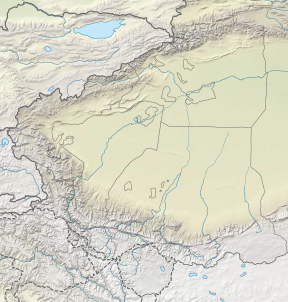Gasherbrum I
| Gasherbrum I | |
|---|---|
| Hidden Peak | |
Ranked 11th | |
| Prominence | 2,155 m (7,070 ft)[1] |
| Isolation | 24 km (15 mi) |
| Listing |
|
Gilgit–Baltistan and Xinjiang
| |
| Parent range | Karakoram |
| Climbing | |
| First ascent |
|
| Easiest route | snow/ice climb |
 | |
Gasherbrum I (
Himalaya. Gasherbrum is often claimed to mean "Shining Wall", presumably a reference to the highly visible face of the neighboring peak Gasherbrum IV; but in fact, it comes from "rgasha" (beautiful) + "brum" (mountain) in Balti
, hence it actually means "beautiful mountain."
Gasherbrum I was designated K5 (meaning the 5th peak of the
William Martin Conway
provided the alternate name, Hidden Peak, in reference to its extreme remoteness.
Gasherbrum I was first climbed on July 5, 1958, by Pete Schoening and Andy Kauffman of an eight-man American expedition led by Nicholas B. Clinch, Richard K. Irvin, Tom Nevison, Tom McCormack, Bob Swift and Gil Roberts were also members of the team.[3]: 210–212
Timeline
- 1934 - A large international expedition, organized by the Swiss G.O. Dyhrenfurth, explores Gasherbrum I and II. Two climbers get to 6,300 m (20,670 ft).[4]
- 1936 - A French expedition gets to 6,900 m (22,640 ft).
- 1958 - An American team led by Nicholas Clinch including two Pakistani army officers captain Mohammad Akram and captain S.T.H Rizvi makes the first ascent, via Roch ridge.[3]: 208
- 1975 - alpine style (first time on an 8000-metre peak) taking three days total.[3]: 212 One day later, a team of three led by Austrian Hanns Schell reached the summit on the American route.[3]: 213
- 1977 - The fourth successful ascent by two Slovenians (Nejc Zaplotnik and Andrej Stremfelj), again on a new route. Team member Drago Bregar died.[3]: 213
- 1980 - Frenchmen Maurice Barrard and Georges Narbaud[3]: 213 are successful with the fifth ascent and pass the South Ridge for the first time.[4]
- 1981 - A Japanese team follows the Clinch route with fixed ropes for the sixth successful ascent.[3]: 214 [4]
- 1982 - Michael Dacher, Siegfried Hupfauer and Günter Sturm of a German expedition summit via a new route on the north face. In the same year, French Marie-José Vallençant is the first woman who reaches the summit. Her husband, Sylvain Saudan from Switzerland, performs the first ski descent from the top of an 8000-metre peak to base camp.
- 1983 - Jerzy Kukuczka with Wojciech Kurtyka, new route. Alpine style ascent without the aid of oxygen.
- 1983 - Teams from Switzerland and Spain are successful.
- 1984 - Reinhold Messner and Hans Kammerlander traverse Gasherbrum II and Gasherbrum I without returning to base camp in between
- 1985 - Solo ascent by Benoît Chamoux. On July 14, the Italian Giampiero Di Federico (solo ascent) opens a new route on the north-west face.[5]
- 1997 - Magnus Rydén and Johan Åkerström reach the summit.
- 2003 - 19 people reach the summit, 4 deaths, including Mohammad Oraz.[6]
- 2012 - March 9, Adam Bielecki and Janusz Gołąb (Poland) made the first winter ascent. The ascent was made without the aid of supplementary oxygen.[7] The same day, three climbers from a different expedition — Austrian Gerfried Göschl, Swiss Cedric Hählen and Pakistani Nisar Hussain Sadpara — went missing, never to be found again. They were trying to ascend via a new route and are considered to have been blown off by strong winds.[8]
- 2013 - 7 July, Artur Hajzer died after falling in the Japanese Couloir after an attempt to reach the summit.[9]
- 2013 - 21 July, Spaniards Abel Alonso, Xebi Gomez and Álvaro Paredes climbed to the top to then disappear while descending after a storm.[10]
- 2017 - 30 July, in an alpine style six-day ascent without supplementary oxygen, Czechs Marek 'Mára' Holeček and Zdeněk Hák established a new route named Satisfaction! (in memory of Zdeněk Hrubý) up the Southwest Face.[11]
See also
- List of mountains in Pakistan
- Highest Mountains of the World
Bibliography
- Carter, H. Adams (1975). "Balti Place Names in the Karakoram". American Alpine Journal. 49: 53.
- Clinch, Nicholas (December 1982). A Walk in the Sky: Climbing Hidden Peak. Seattle, WA, USA: The Mountaineers. ISBN 0-89886-042-3.
- Fanshawe, Andy; Venables, Stephen (March 1996). Himalaya alpine-style: the most challenging routes on the highest peaks. Seattle, WA, USA: Mountaineers Books. ISBN 0-34064-931-3.
Notes and references
- ^ a b "Gasherbrum I". Peakbagger.com. Retrieved 2014-08-24.
- ^ "Trekking Routes - Highest peaks". cknp.org. Archived from the original on 2019-10-09. Retrieved 2014-08-24.
- ^ ISBN 0898860423.
- ^ a b c "Gasherbrum I: Some background and History". k2news.com. Retrieved 2014-01-04.
- ^ Fanshawe & Venables "Himalaya alpine-style"
- ^ "Everest Summiter Mohammad Oraz death/Iranian expedition". k2news.com. September 2003. Retrieved 2014-01-04.
- ^ "Polish Winter Himalayan Mountaineering 2010-2015". Polishwinterhimalaism.pl. March 9, 2012. Archived from the original on July 8, 2012. Retrieved 2012-08-17.
- ^ "Three missing mountaineers feared dead, rescue mission called off". dawn.com. March 15, 2012. Retrieved 2012-03-15.
- ^ Crothers, David (16 July 2013). "Iconic Polish Climber Artur Hajzer Dies on Gasherbrum I". Retrieved 25 July 2018.
- ^ "Se da por desaparecidos a Xevi Góméz, Álvaro Paredes y Abel Alonso en el G1". 26 July 2013. Retrieved 25 July 2018.
- ^ "Gasherbrum I SW Face, big new route by Marek Holeček and Zdeněk Hák". Planet Mountain. 11 August 2017. Retrieved 1 May 2018.
External links
- Gasherbrum I on Summitpost
- Gasherbrum I on Himalaya-Info.org (German)
- "Gasherbrum I". Peakware.com. Archived from the original on 2016-03-04.
- Summit Video of Alex Gavan's First Romanian Ascent of Gasherbrum 1 (July 30th 2007)


